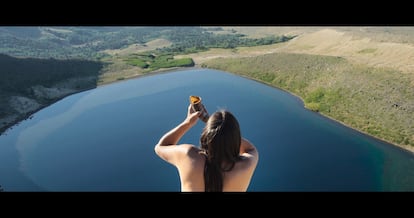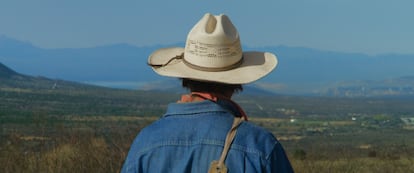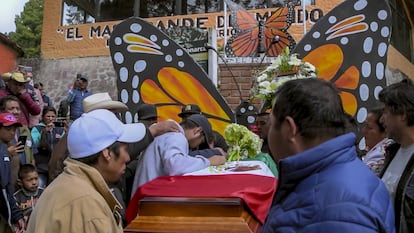Killing environmental activists, that old Latin American custom reflected in cinema

March 8 marked four months since the disappearance of 72-year-old Mapuche leader and environmental defender Julia Chuñil . Her family accuses a forestry entrepreneur of being responsible, who is engaged in a legal dispute over a nature reserve defended by the activist. For the nearly two million Mapuche —an indigenous nation located in Araucanía, present-day Chile —harassment by landowners and the Chilean army has become commonplace. The wound from the 2008 murder of 22-year-old protester Matías Catrileo at the hands of a police officer still bleeds. The land reclamation campaign she spearheaded during her final days is captured in Alejandro Valdeavellano's film , Algún día las raíces (Someday the Roots) . The film was commercially released in 2024 and screenings are now being organized in the ancestral Wallmapu territory.
Of the 196 land and environmental activists who were murdered in 2023, 166 died in Latin America, 85%, according to the British NGO Global Witness . Events like that of Catrileo and other recent ones have become a symbol of the search for justice and resistance. These are echoes of the deaths of Homero Gómez , who was trying to prevent illegal logging in the forest of Michoacán (Mexico); Berta Cáceres , for preventing the development of a hydroelectric project on the Gualcarque River in Honduras; Julián Carrillo, who opposed the settlement of Canadian mining companies in the Mexican mountains of Chihuahua ; or, earlier, Chico Mendes , after investigating the illegal expropriation of land in the Brazilian Amazon. Films such as The Guardian of the Monarchs (2024), Berta is Me (2022), The White Guard (2022) and Povo da Floresta (Forest People, 2020) tell their stories and struggles.

“Mapuche activists have been killed under every democratic government. Now, under Gabriel Boric's administration, the military presence in the territory has increased, with tanks and investment in weapons and transportation to different areas of the Wallmapu territory,” explains Alejandro Valdeavellano, director of Algún día las raíces (Someday the Roots). He reconstructed the life of his protagonist through the stories of family, friends, partners, and loved ones. “The idea was to make a film of denunciation and memory.”
Thus, in parallel, in two stages, the film recounts how his mother's Native ancestry influenced the Chilean filmmaker's ideas and, in a thriller-like tone, the "territorial recoveries" in which he not only participated but also encouraged and directed. Territorial recovery is understood as the reclaiming and replacing of land that was usurped and annexed to the Chilean state during the so-called occupation of Araucanía , between 1851 and 1883.

Some land reclamations are carried out with violence: Catrileo was shot while entering a private property. “The government has institutionalized the restoration process, requiring communities to provide documents proving ownership of their land. Many of them don't have them, or the title doesn't cover the entire geographic area to which they are entitled. It's a term that seeks bureaucracy and institutional distance to resolve this conflict,” Valdeavellano asserts over the phone from Santiago.
55 years of deforestation in the AmazonForest people It is also a memory film about a problem that has changed little over the years. Documentary filmmaker Rafa Calil presents the film as a tribute to Chico Mendes , a rubber tapper who became a union leader and activist in the 1970s, considered the first martyr of the ecology. He was murdered in 1988 by two wealthy landowners. The documentary delves into the lives of the rubber tappers and Conservation Unit agents in the Chico Mendes Reserve , in the Brazilian state of Acri, to show that they continue to live under threat. Deforestation, Mendes's enemy, continues to rampant: as of 2022, 26% of the 847 million hectares that make up the Amazon have suffered irreversible deforestation .
Of every 10 deaths in this jungle town, nine are environmental defenders, according to one of the police officers interviewed in the film. Brazil is the Latin American country with the second highest number of environmental activists killed in 2023, with 25 murdered. Colombia tops the list with 79, and Mexico is third with 18. In the latter, criminal organizations have joined forces with landowners and businessmen with agrarian interests as executioners. The communal commissioner of the Monarch Butterfly Biosphere Reserve, Homero Gómez, confronted them. The Guardian of the Monarchs, directed by Emiliano Ruprah, It tells how this World Heritage Site, the arrival point for a 5,000-kilometer migration of lepidopterans, is threatened by illegal logging.

“After the war on drugs waged by President Felipe Calderón and his Secretary of Public Security, Genaro García Luna , organized crime needed to find other sources of income. These included collecting land use 'rights,' extorting businesses, and seizing natural resources,” says director Emiliano Ruprah. At least 70% of Mexico's timber harvest is illegal, according to the National Autonomous University of Mexico (UNAM). “In many cases, mafias are involved in working with large companies for economic gain, or with politicians who oppose the defense and protection of areas with significant resources,” adds Ruprah.
Killed by cartelsWithout the fir and pine trees that populate the reserve, the butterflies are left without a winter refuge. The 14 criminal groups estimated to operate in Michoacán , including the Jalisco Nueva Generación and Sinaloa cartels , considered terrorists, have set up drug labs there. Gómez's years-long battle came to an end on January 13, 2020, when she disappeared. Her body was found in a well 19 days later.
But Mexico's western coast isn't the only place where criminal organizations have transformed into illegal mining operations. More than 500 kilometers north, in the state of Zacatecas, lies Salaverna . A small town where its inhabitants were dispossessed by the so-called "white guard": armed irregular groups working for a company, in this case, the Canadian mining company Frisco . It is one of the three locations inJulien Elie 's feature-length documentary "The White Guard ."
An estimated 264 mining companies are located in Mexico, 80% of which are Anglo-American . Rarámuri community leader Julián Carrillo , who was shot dead in 2018, and another of the film's protagonists, took a stand against several of them. His son, nephew, and son-in-law were found dead before him. The third setting addressed in The White Guard is the Verde River, the center of life and production in a community in Oaxaca threatened by pollution from mining activity.

“It's an isolated place, a paradise for American tourists. That speaks volumes about Mexico's history. The violence takes place against a backdrop of tranquility and natural beauty,” says Julien Elie. A contradiction that is reflected in the film's visuals: an all-encompassing nature with its shades of green contrasting with the ochre excavations left by mining activity. Elie asserts that it is the State's responsibility to maintain an artificial, peaceful vision: “In Mexico, different levels of government, from national to municipal, work with criminal groups. The police and the army are permissive or absent in these no-man's-land.”
Government complicityIt was the State that obstructed the investigation for five years to discover the mastermind behind the death of Honduran Berta Cáceres . Filmmaker Katia Lara filmed her actions for almost 10 years in Berta Soy Yo . From the moment the activist declared war on the DESA company and its hydraulic project on the Gualcarque River , the source of life for the Lenca nation, until her murder in 2016 and the subsequent trials. Cáceres was an international symbol, receiving the Goldman Prize and the constant admiration of Pope Francis , and her death was mourned on newscasts from Kenya to the United States.

The resolution of the case was slow. One minister even called the crime "a crime of passion," and the perpetrators, DESA executives, were covered up for being former government officials. Finally, in 2022, David Castillo, the company's former director and former officer of the Honduran military intelligence service, was sentenced .
The notion of the direct or indirect involvement of states, or their judicial branches, in the deaths of environmental activists hovers throughout all these films. Catrileo's killer, Agent Walter Ramírez, never set foot in jail despite being sentenced to three years in 2011; the Mexican prosecutor's office declared environmentalist Gómez's cause of death "accidental drowning"; Carrillo was shot despite being part of Mexico's protection system... What remains, says filmmaker Ruprah, are militant films. Distributing information, questioning authorities, and highlighting the impunity of crimes.
EL PAÍS


%3Aformat(jpg)%3Aquality(99)%3Awatermark(f.elconfidencial.com%2Ffile%2Fbae%2Feea%2Ffde%2Fbaeeeafde1b3229287b0c008f7602058.png%2C0%2C275%2C1)%2Ff.elconfidencial.com%2Foriginal%2F8e0%2F88e%2F0ae%2F8e088e0ae51bcbaff520239d45caa8db.jpg&w=3840&q=100)


